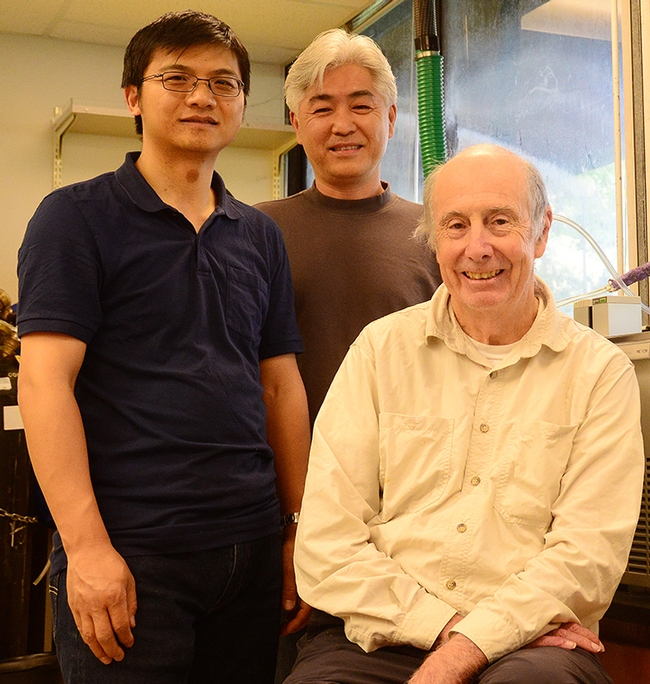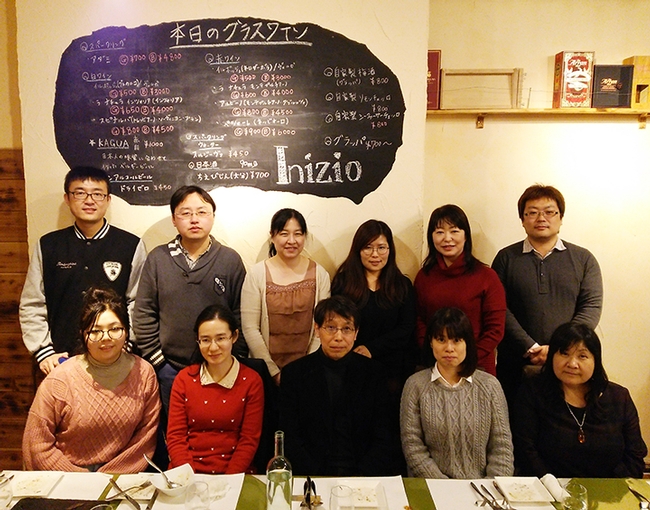- Author: Kathy Keatley Garvey

ASD, which impacts the nervous system, affects 1 percent of the U.S. population or 62.2 million globally. An estimated 64 percent and 91 percent of the population are at risk genetically.
The researchers' latest paper, “Maternal Glyphosate Exposure Causes Autism-Like Behaviors in Offspring through Increased Expression of Soluble Epoxide Hydrolase,” appears in the current edition of the Proceedings of the National Academy of Sciences (PNAS). Glyphosate is a broad-spectrum systemic herbicide and crop desiccant used to kill broadleaf weeds and grasses that compete with agricultural crops.
“In the research of autism, brain-gut-microbiota axis plays a key role in ASD from human studies,” said lead researcher and neurobiologist Kenji Hashimoto of the Division of Clinical Neuroscience, Chiba University Center for Forensic Mental Health, Chiba, Japan. “Accumulating evidence suggests abnormal composition of gut microbiota in subjects with autism. In this study, we found abnormal composition of gut microbiota in offspring after maternal glyphosate exposure. Thus, exposure of glyphosate during pregnancy may cause abnormal composition of gut microbiota in offspring, resulting in the risk for autism.'
The drug discovered in the Hammock lab inhibits sEH, a natural enzyme that regulates epoxy fatty acids, “which control blood pressure, fibrosis, immunity, tissue growth, depression, pain and inflammation to name a few processes,” said co-author Hammock, a distinguished professor with a joint appointment in the UC Davis Department of Entomology and Nematology and the UC Davis Comprehensive Cancer Center. Human clinical trials underway to see if the non-addictive drug relieves chronic pain.
“It is critical to appreciate that mouse models are not absolutely predictive of the human situation,” Hammock said.“Similarly, maternal immune stress is simply a model that gives behavioral changes in the offspring. That said, it is a relevant model of abnormalities in mental development in the offspring. This is a widely used model of the effect of maternal stress on the next generation that has been established in many species, including nonhuman primates. Sadly, maternal stress was shown tightly associated with the mental state of human children as well.”

“Such studies are important to generate hypotheses of environmental risk,” said Hammock, who meshes his expertise in chemistry, toxicology, biochemistry and entomology, in his 50-year research to find a non-addictive drug to control chronic pain. “Because we only saw maternal immune stress at exceptionally high doses of glyphosate, our data fail to support the hypothesis that glyphosate exposure causes autism with expected dietary, environmental or even occupational exposure.”
The research drew financial support from the Japan Society for the Promotion of Science (to Hashimoto); and the National Institute of Environmental Health Sciences (NIEHS) River Award (to Hammock), and NIEHS Superfund Program (to Hammock). Hammock has directed the UC Davis Superfund Program for nearly four decades.
The Hashimoto-directed Chiba group has shown that these drug candidates prevent and even reverse a variety of chronic diseases of the central nervous system in mice and human cells including ASD like behaviors.
The 16 co-authors include Hammock lab researchers Jun Yang, Sung Hee Hwang and Debin Wan.
Yang said that the researchers “hypothesized that the role of the sEH is important in the pathogenesis of ASD in offspring after maternal glyphosate exposure based on our previous finding that sEH plays a key role in the development of ASD-like behavioral abnormalities in juvenile offspring after maternal immune activation (MIA), a prenatal environmental factor.”
Said Hwang: “Some epidemiological studies suggest an association between glyphosate use in agriculture and increases in autism like disorders. The doses we used in mice were so high that we fail to support glyphosate epidemiological associations between the herbicide use and the cause ASD-like behaviors.
The PNAS abstract:
“Epidemiological studies suggest that exposure to herbicides during pregnancy might increase risk for autism spectrum disorder (ASD) in offspring. However, the mechanisms underlying the risk of ASD by herbicides such as glyphosate remain unclear. Soluble epoxide hydrolase (sEH) in the metabolism of polyunsaturated fatty acids is shown to play a key role in the development of ASD in offspring after maternal immune activation. Here, we found ASD-like behavioral abnormalities in juvenile offspring after maternal exposure to high levels of formulated glyphosate.
“Furthermore, we found increases in sEH in the prefrontal cortex (PFC), hippocampus, and striatum of juvenile offspring and oxylipin analysis showed decreased levels of epoxy-fatty acids such as 8(9)-EpETrE in the blood, PFC, hippocampus, and striatum of offspring after maternal glyphosate exposure, supporting increased activity of sEH in the offspring. Moreover, we report abnormal composition of gut microbiota and short chain fatty acids in fecal samples of juvenile offspring after maternal glyphosate exposure. Interestingly, oral administration of TPPU (an sEH inhibitor) to pregnant mothers from E5 to P21 prevented ASD-like behaviors such as social interaction deficits and increased grooming time in the juvenile offspring. These findings suggest that maternal exposure to high levels of glyphosate causes ASD-like behavioral abnormalities and abnormal composition of gut microbiota in juvenile offspring, and that increased activity of sEH might play a role in ASD-like behaviors in offspring after maternal glyphosate exposure. Therefore, sEH may represent a target for ASD in offspring after maternal stress from occupational exposure to contaminants.
“Maternal exposure to high levels of the herbicide glyphosate may increase the risk for autism spectrum disorder (ASD) in offspring; however, the underlying mechanisms remain largely unknown. Maternal glyphosate exposure during pregnancy and lactation caused ASD-like behavioral abnormalities and abnormal composition of gut microbiota in murine male offspring. Soluble epoxide hydrolase (sEH) in the brain of offspring after maternal glyphosate exposure was higher than controls. Treatment with an sEH inhibitor from pregnancy to weaning prevented the onset of ASD-like behavioral abnormalities in offspring after maternal glyphosate exposure. The glyphosate exposures used here exceed any reasonable dietary, environmental or occupational exposure, but they indicate that increased sEH plays a role in ASD-like behaviors in offspring.”
- Author: Kathy Keatley Garvey
An enzyme inhibitor developed in the UC Davis laboratory of Bruce Hammock and tested in mice by a team of international researchers shows promise that it could lead to a drug to prevent or reduce the disabilities associated with the neurodevelopmental disorders of autism and schizophrenia.
“We discovered that soluble epoxide hydrolase (sEH) plays a key role in inflammation associated with neurodevelopmental disorders. Inhibiting that enzyme stops the inflammation and the development of autism-like and schizophrenia-like symptoms in animal models,” said collaborator Kenji Hashimoto, a professor with the Chiba University Center for Forensic Mental Health, Japan. The scientists found higher levels of sEH in a key region of the brain—the prefrontal cortex of juvenile offspring-- after maternal immune activation (MIA).
“Mothers who have MIA, which results from severe stress in that region of the brain, have an increased occurrence of neurodevelopment disorders in their offspring,” Hashimoto explained. “In our study, the sEH enzyme increased dramatically in a key brain region of mice pups from mothers with MIA.”
The research, published today (March 18) in the Proceedings of the National Academy of Sciences (PNAS), is the work of 14 researchers from Chiba University Center for Forensic Mental Health; the Laboratory for Molecular Psychiatry, RIKEN Center for Brain Science, in Wako, Saitama, Japan; and the Hammock laboratory.
Research in Mice Pups
By inhibiting sEH, the researchers reversed cognitive and social interaction deficiencies in the mice pups. They hypothesize that this is due to increasing natural chemicals, which prevent brain inflammation. In people, this could reduce the disabilities associated with autism, such as anxiety, gastrointestinal disturbances and epilepsy.
“The same chemical and biochemical markers behaved as predicted in human stem cells,” said Hammock, a distinguished professor who holds a joint appointment with the Department of Entomology and Nematology and the UC Davis Comprehensive Cancer Center.
Earlier studies have indicated a genetic disposition to the disorders. The team also studied postmortem brain samples from autism patients that confirmed the alterations.
“In the case of both autism and schizophrenia, the epidemiology suggests that both genetics and environment are contributing factors,” said neuroscientist and associate professor Amy Ramsey of the Department of Pharmacology and Toxicology, University of Toronto, who was not involved in the study. “In both cases, maternal infection is a risk factor that might tip the scales for a fetus with a genetic vulnerability. This study is important because it shows that their drug can effectively prevent some of the negative outcomes that occur with prenatal infections. While there are many studies that must be done to ensure its safe use in pregnant women, it could mitigate the neurological impacts of infection during pregnancy.”
Neuroscientist Lawrence David, professor and chair of the School of Public Health, University of Albany, N.Y., who was not involved in the research, said that the study might lead to “an important therapeutic intervention for neurodevelopment disorders.”
Might Be Important Therapeutic Invervention
“There is increasing evidence that maternal immune activation activities (MIA) during fetal development can lead to aberrant neurobehaviors, including autistic-like activities,” said Lawrence, who studies neuroimmunology and immunotoxicology. The study “suggests that enzymatic control of fatty acid metabolism is implicated in neuroinflammation associated with schizophrenia and autism spectrum disorders. The expression of Ephx2 giving rise to soluble epoxide hydrolase (sEH) influences production of fatty acid metabolites, which elevate inflammation in the experimental model of mice after MIA; the sEH inhibitor TPPU (N-[1-(1-oxopropyl)-4-piperidinyl]-N'-[4-(trifluoromethoxy)phenyl)-urea) was postnatally used to improved behaviors. Analysis of cadaver brains from individuals with ASD also expressed increased sEH. Fatty acid metabolites have been known to affect fetal development, especially that of the brain; therefore, TPPU might be an important therapeutic intervention for neurodevelopmental disorders.”
Molecular bioscientist Isaac Pessah of the UC Davis School of Veterinary Medicine, distinguished professor and associate dean of research and graduate education in the Department of Molecular Biosciences, described the findings as “significant” and called for more detailed and expanded studies.
“There is mounting evidence that inappropriate maternal immune responses during pregnancy to infection contributes elevated risk to autism spectrum disorder, at least in a fraction of cases,” Pessah said. “The most significant findings reported here is that a commonly used mouse model of immune-triggered behavioral deficits mimicking some of the core symptoms in autistic children can be suppressed by inhibiting a novel biochemical target, soluble epoxide hydrolase; a target not previously explored as a target for therapeutic intervention to treat ASDs. These findings provide a rational basis for more detailed and expanded studies in mice carrying mutations implicated in ASDs to determine whether the therapeutic benefits of soluble epoxide hydrolase inhibitor(s) observed in this study are more generalizable.”
Autism in the United States
The Center for Disease Control and Prevention (CDC) estimates that 1 in 68 children in the United States have autism, commonly diagnosed around age 3. It is four times more common in boys than girls. CDC defines autism spectrum disorder as a “developmental disability that can cause significant social, communication and behavioral challenges.” The disorder impairs the ability to communicate and interact.
Approximately 3.5 million people or 1.2 percent of the population in the United States are diagnosed with schizophrenia, one of the leading causes of disability, according to the Schizophrenia and Related Disorders Alliance of America (SARDAA). Scores more go unreported. Approximately three-quarters of persons with schizophrenia develop the illness between 16 and 25 years of age. Statistics also show that between one-third and one half of all homeless adults have schizophrenia, and 50 percent of people diagnosed have received no treatment. Among the symptoms: delusions, hallucinations, disorganized speech, disorganized or catatonic behavior, and obsessive-compulsive disorders, such as hoarding, according to SARDAA.
Promising Prophylactic or Theraputic Target
In their research paper, titled “Key Role of Soluble Epoxide Hydrolase in the Neurodevelopmental Disorders of Offspring After Maternal Immune Activation,” the scientists described sEH as “a promising prophylactic or therapeutic target for neurodevelopmental disorders in offspring after MIA.”
First author Min Ma and second Qian Ren of the Hashimoto lab conducted the animal and biochemical work, while chemists Jun Yang and Sung Hee Hwang of the Hammock lab performed the chemistry and analytical chemistry. Takeo Yoshikawa, a team leader with the RIKEN's Molecular Psychiatry Laboratory, performed measurements of gene expression in the neurospheres from iPSC (induced pluripotent stem cells) from schizophrenia patients and postmortem brain samples from autism patients.
Hashimoto described the international collaboration as “exciting and productive.” This is their third PNAS paper in a series leading to endoplasmic reticulum stress. “We report discovery of a biochemical axis that leads to multiple neurological disorders, including depression, Parkinson's disease, schizophrenia, autism spectrum disorders and similar diseases,” he said.
First Human Trials
William Schmidt, vice president of clinical development at EicOsis, a Davis-based company developing inhibitors to sEH to treat unmet medical needs in humans and companion animals, said the company is developing a first-in-class therapy for neuropathic and inflammatory pain. “EicOsis is in the process of finalizing our first human trials on the inhibitors of the soluble epoxide hydrolase, originally reported from UC Davis,” Schmidt said. “We are targeting the compounds as opioid replacements to treat peripheral neuropathic pain. It is exciting that the same compound series may be used to prevent or treat diseases of the central nervous system.”
Several grants from the National Institutes of Health, awarded to Hammock, supported the research. Hammock praised the many collaborators and students he has worked with on the project. “This work illustrates the value of research universities in bringing together the diverse talent needed to address complex problems,” Hammock said. “It also illustrates the value of fundamental science. This autism research can be traced directly to the fundamental question of how caterpillars turn into butterflies.”
Now working solely on research to benefit humankind, Hammock began his career in insect science at UC Berkeley where he investigated how epoxide hydrolase degrades a caterpillar's juvenile hormone. The process leads to metamorphosis from the larval stage to the adult insect. Hammock then wondered "Does the enzyme occur in plants? Does it occur in mammals?"
It does, and particularly as a soluble epoxide hydrolase in mammals.
"Science is full of surprises," said Hammock, who founded EicOsis to help human patients conquer pain without opioids. "We need to remember that the concept, the clinical target, and even the chemical structure, came from asking how caterpillars turn into butterflies."
____________________________________________________________________________________________
ABSTRACT, PNAS Paper, "Key Role of Soluble Epoxide Hydrolase in the Neurodevelopmental Disorders of Offspring After Maternal Immune Activation"
“Maternal infection during pregnancy increases the risk of neurodevelopmental disorders such as schizophrenia and autism spectrum disorder (ASD) in offspring. In rodents, maternal immune activation (MIA) yields offspring with schizophrenia- and ASD-like behavioral abnormalities. Soluble epoxide hydrolase (sEH) plays a key role in inflammation associated with neurodevelopmental disorders. Here we found higher levels of sEH in the prefrontal cortex (PFC) of juvenile offspring after MIA. Oxylipin analysis showed decreased levels of epoxy-fatty acids in the PFC of juvenile offspring after MIA, supporting increased activity of sEH in the PFC of juvenile offspring. Furthermore, the expression of sEH (or EPHX2) mRNA in iPSC-derived neurospheres from schizophrenia patients with the 22q11.2 deletion was higher than that of healthy controls. Moreover, the expression of EPHX2 mRNA in the postmortem brain samples (Brodmann area 9 and 40) from ASD patients was higher than that of controls. Treatment of TPPU (a potent sEH inhibitor) into juvenile offspring from P28 to P56 could prevent cognitive deficits and loss of parvalbumin (PV)-immunoreactivity in the medial PFC of adult offspring after MIA. In addition, dosing of TPPU to pregnant mothers from E5 to P21 could prevent cognitive deficits, and social interaction deficits and PV-immunoreactivity in the mPFC of juvenile offspring after MIA. These findings suggest that increased activity of sEH in the PFC plays a key role in the etiology of neurodevelopmental disorders in offspring after MIA. Therefore, sEH would represent a promising prophylactic or therapeutic target for neurodevelopmental disorders in offspring after MIA.”
Related Research Published in PNAS
- Soluble Epoxide Hydrolase Plays a Key Role in the Pathogenesis of Parkinson's Disease
- Gene Deficiency and Pharmacological Inhibition of Soluble Epoxide Hydrolase Confers Resilience to Repeated Social Defeat Stress
Contacts:
Bruce Hammock, bdhammock@ucdavis.edu
Kenji Hashimoto, hashimoto@faculty.chiba-u.jp






